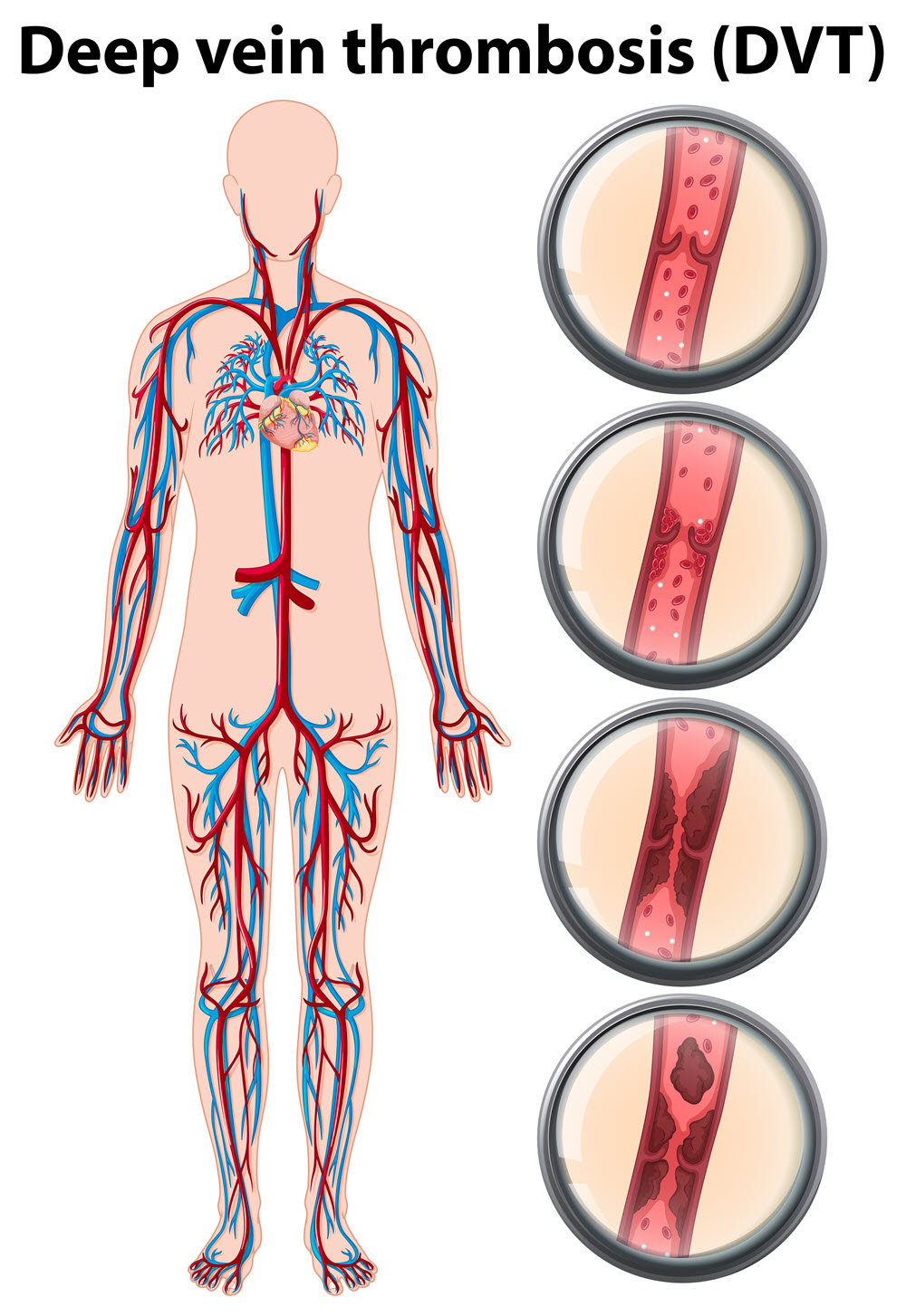Heart & Cardiovascular
Deep Vein Thrombosis (DVT)
By S.I. (staff writer) , published on January 10, 2022

Medicine Telehealth Health clotting hypertension
What is Deep Vein Thrombosis (DVT)?
Deep vein thrombosis (DVT) is a medical condition characterized by the formation of blood clots in deep veins of the body, especially in the deep veins of the legs. It can occur in other parts of the body as well. It is a serious venous thromboembolism disorder that is the third most common cause of death after a heart attack and stroke across the globe [1].
Venous thromboembolism refers to the formation of blood clots (thrombus) in the deep vein veins of the body (deep vein thrombosis) and their movement in circulation (embolism), and then lodgement in the lungs (pulmonary embolism). The signs and symptoms include tachycardia, shortness of breath, severe chest pain, and lightheadedness.
Mortality and morbidity rates have significantly decreased by adopting preventive measures and taking medicines to dissolve the clots. Deep vein thrombosis is usually manifested in the form of pain, swelling, and tenderness in the affected area or body part. If not treated, it can lead to pulmonary embolism and even death.
What are the Types of Deep Vein Thrombosis (DVT)?
There are two main types of deep vein thrombosis [2]:
- Acute deep vein thrombosis
- Chronic deep vein thrombosis
What are the Signs and Symptoms of Deep Vein Thrombosis (DVT)?
The signs and symptoms of deep vein thrombosis vary from patient to patient. The symptoms range from mild to severe in intensity. Following are some important signs and symptoms of deep vein thrombosis [3]:
- Swelling mostly in one leg
- Pain
- Cramping
- Soreness
- The sensation of heat in the affected body part
- Enlarged veins
- Edema in limbs (unilateral or bilateral)
- Redness on the affected area
- Discoloration of the skin of the affected area
- Tenderness
What are the Causes of Deep Vein Thrombosis (DVT)?
DVT can be due to various reasons. Here are some important causes of deep vein thrombosis [4]:
- Inflammation due to injury and infection
- Damage to the vein due to trauma or during surgery
- Increased coagulability of blood promoting clot formation
- Thrombophlebitis (increased formation of blood clots)
- Splenectomy
- Polycythemia Vera is associated with an increased level of platelets and blood cells.
- idiopathic deep vein thrombosis
- Abnormal blood flow (stasis or turbulence) also increases the incidence of deep vein thrombosis.
- Severe varicose veins are associated with an increased risk of deep vein thrombosis.
- Immobility for a long period e.g., in bedridden patients
- Prolonged bed rest after accident or trauma.
- Birth control pills can cause increased coagulability and increase the incidence of clot formation and deep vein thrombosis.
- Congenital deficiency of thrombolytic factors increases the incidence of deep vein thrombosis.
What are the Treatment Options for Deep Vein Thrombosis (DVT)?
Following treatment options can help treat deep vein thrombosis and improve the quality of life [5]:
- Anticoagulants or blood thinners: these drugs decrease blood clotting and thrombosis. Some important anticoagulants are listed below:
- Lower molecular weight heparin (LMWH)
- Unfractionated heparin (UFH)
- Fondaparinux
- Rivaroxaban
- Apixaban
- Edoxaban
- Warfarin
- Dabigatran
- Thrombolytics: these drugs can break blood clots. Some important thrombolytics are:
- Urokinase
- Alteplase
- Streptokinase
- An inferior vena cava filter: the filter prevents the blood with clots from reaching the lungs.
- Thrombectomy
- Embolectomy
- Compression stockings: using compression stocking minimizes the chances of blood pooling, clot formation, thrombosis, and embolism.
References:
- https://www.ncbi.nlm.nih.gov/books/NBK507708/#:~:text=Deep%2Dvein%20thrombosis%20is%20a,after%20heart%20attacks%20and%20stroke.
- https://www.ncbi.nlm.nih.gov/books/NBK507708/
- https://www.ncbi.nlm.nih.gov/pmc/articles/PMC3262341/#:~:text=Lower%20extremity%20DVT%20can%20be,tenderness%2C%20and%20lower%20extremity%20swelling.
- https://www.ncbi.nlm.nih.gov/books/NBK507708/#:~:text=Risk%20Factors,-Following%20are%20the&text=Mechanical%20injury%20to%20the%20vein,anatomy%20can%20contribute%20to%20thrombosis.
- https://www.ncbi.nlm.nih.gov/pmc/articles/PMC1609160/#:~:text=The%20mainstay%20of%20treatment%20of,of%20most%20patients%20with%20DVT
Find articles related to: Medicine Telehealth Health clotting hypertension
More articles about Heart & Cardiovascular
Back to the Health Tips Index




